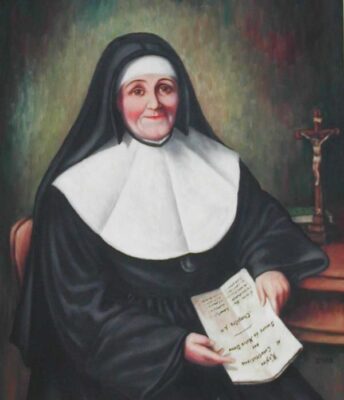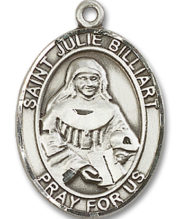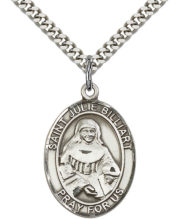Saints
St. Julie Billiart Medal – 7 Lessons You Can Learn Regarding Suffering
Discover 7 Lessons You Can Learn from St. Julie Biliart On What it Means to Suffer for Christ
 Twenty-two-year-old Saint Julie Billiart was sewing in the kitchen of the family home in the village of Cuvilly, France, and talking with her father who was sitting nearby. Suddenly the quiet of the winter night was shattered as a stone came crashing through the window. Then Julie was horrified to see a gun barrel come through the window, pointed in the direction of her father. A piercing shot rang out. This shot from an unknown enemy fortunately missed Jean Francois Billiart, but it marked a turning point in the life of Julie. The shot, which was fired in the year 1774, was such a shock to her nervous system that she suffered in all her limbs.
Twenty-two-year-old Saint Julie Billiart was sewing in the kitchen of the family home in the village of Cuvilly, France, and talking with her father who was sitting nearby. Suddenly the quiet of the winter night was shattered as a stone came crashing through the window. Then Julie was horrified to see a gun barrel come through the window, pointed in the direction of her father. A piercing shot rang out. This shot from an unknown enemy fortunately missed Jean Francois Billiart, but it marked a turning point in the life of Julie. The shot, which was fired in the year 1774, was such a shock to her nervous system that she suffered in all her limbs.
1) Offer Your Suffering to God
By 1782 she was a helpless cripple and she remained so until 1804. She suffered for thirty years, and for twenty-two of these thirty years she was almost completely helpless. Julie had been so well known for her piety and for her charity, even before she was stricken, that the townspeople called her “The saint of Cuvilly.” Now, she looked upon her afflictions as an extra gift to offer to God. Through her sufferings she offered reparation to the Sacred Heart of Jesus for all the sins of the world, especially for those committed against the Sacrament of the Altar.
The French Revolution broke out in 1789 and reached its height in the Reign of Terror of 17931794 Churches and convents were destroyed, and priests and religious put to death or sent into exile. Freethinkers ridiculed the existence of God. Sixteen nuns from the nearby Carmelite convent – all friends of Julie – were marched to the guillotine. Julie escaped a like fate only because friends hid her in a cart under some straw while a mob ransacked the house where she had been hiding. She changed residences frequently to avoid annoyance to her friends and betrayal by enemies of the Church The frequent movings added to the pain that she would have been suffering anyway. Her malady was so aggravated that for several months she almost completely lost her power of speech.
2) Your Suffering on Earth Binds You to the Suffering of Jesus Christ
In 1795, Julie wrote to a friend: “You wish me to speak of my wretched body. It is not worth the trouble, but, since you wish it I will tell you that it is worth nothing, nothing at all. My days, thanks be to God, are full of suffering, and my nights are some times worse. But, my dear good friend, what are my sufferings compared with the love God has for me? Yes, I confess I am indeed happy when the good God gives me the grace to suffer much. Then I give a little share to all my good friends in the Faith, through the infinite merits of our good Savior.“
3) Turn Always to the Eucharist
Her physical pain was far less acute than the pain of being deprived of Mass and Holy Communion, while enduring spiritual desolation. Julie had been permitted to make her First Communion at the age of nine, a very unusual privilege in those days, and at the age of twenty she had been permitted to receive Communion daily. But now, during the Revolution, priests were being hunted down like animals, and it was seldom that she could hear Mass or receive the sacraments.
During this dangerous period, Julie had a vision of the future Institute of Notre Dame. She saw Jesus on Calvary; gathered around the foot of His cross were a group of Sisters whose faces were so distinct that she recognized them years later when she met them. Before the vision faded, Julie heard a voice say: “Behold the spiritual daughters whom I give to you in the Institute which will be marked by my Cross.” Often during the dark years that followed, Julie was strengthened by the memory of this vision.
4) Find Christ in the Poor
 At the Hotel de Blin, a hospital in Amiens where Julie was taken for safety during the Terror, she met Marie Louise Francoise Blin de Bourdon who was to be associated with her in all her future work. In 1797 Julie and Marie Louise moved to Bettencourt, and there they met Father Joseph Varin who was to encourage them in the founding of the Institute of Notre Dame.
At the Hotel de Blin, a hospital in Amiens where Julie was taken for safety during the Terror, she met Marie Louise Francoise Blin de Bourdon who was to be associated with her in all her future work. In 1797 Julie and Marie Louise moved to Bettencourt, and there they met Father Joseph Varin who was to encourage them in the founding of the Institute of Notre Dame.
The persecution was coming to an end, and there was a great need for women who would assist in the Christian education of the young. This apostolate had always been dear to the heart of Julie, and she had always engaged in it to the limit of her strength. In August, 1803, Julie and Marie Louise moved to a large house in Amiens and here, with the approval of the bishop, began the Institute of Notre Dame.
The Institute was to devote itself primarily to the spiritual care of poor children but also to the Christian education of girls in all classes and to the training of religious teachers. Soon several postulants joined Julie and Marie Louise. An orphanage was opened and evening catechism classes were started. “My daughters,” said Julie to the postulants, “think how few priests there are now, and how many poor children are sunk in the grossest ignorance. We must make it our task to win them back!”
5) Join Your Life to the Sacred Heart of Jesus
In 1804 Pope Pius VII proclaimed a jubilee to celebrate the fact that the religious persecution in France had come to an end. Missions were held all over the country to rekindle the religious fervor that had been dimmed by the Revolution. Julie and her companions helped by teaching women and children to profit by the jubilee.
One of the most arduous workers among the priests giving the missions was Father Enfantin, who had been ordained in a barn during the Reign of Terror. One day Father Enfantin said to Mother Julie: “I am beginning a novena to the Sacred Heart today for a person in whom I am interested. Will you join me in it?”
Julie prayed earnestly for the unknown intention. The fifth day of the novena was the first day of June, month of the Sacred Heart Toward evening, while Julie was sitting in the garden, Father Enfantin came to her and said: “Mother, if you have any faith, take one step in honor of the Sacred Heart of Jesus.”
Instantly Julie took one step. “Take another,” said the priest. And she did.
“And another!”
Julie was completely cured of paralysis from that moment. Her health restored, Julie threw herself into the work of the Institute with great vigor. Convents were opened at Namur, Ghent, Tournai, and other places until within Julie’s lifetime there were ten of them.
6) Never Lose Your Faith
 There were some serious setbacks. Because of a misunderstanding the Bishop of Amiens virtually expelled Julie from the diocese. She moved to Namur and made her headquarters there. Later, the Bishop of Amiens acknowledged his error and invited Julie to return. This was not practical, and Namur remained the center of the Institute. Some of the houses of the Institute suffered greatly during the closing years of the Napoleonic Wars.
There were some serious setbacks. Because of a misunderstanding the Bishop of Amiens virtually expelled Julie from the diocese. She moved to Namur and made her headquarters there. Later, the Bishop of Amiens acknowledged his error and invited Julie to return. This was not practical, and Namur remained the center of the Institute. Some of the houses of the Institute suffered greatly during the closing years of the Napoleonic Wars.
The poverty that followed the French Revolution was also a great handicap. God consoled Mother Julie during these troubles by revealing to her the future expansion of her work. God blessed her with the gift of healing, which she used in the terrible year of 1808 by curing twenty-three sisters who were desperately ill of typhoid.
Her associates believed she also had the power of multiplying the necessities of life, a power of great value in those days of grinding poverty. At the beginning of 1816 Mother Julie was failing in strength. In the evening of Palm Sunday, April 7, she was heard softly saying the Magnificat. After she finished it, she did not speak again. She died peacefully the next morning at two o’clock in the presence of the chaplain and a few Sisters.
7) Dedicate Your Life to Christ
Mother Julie was beatified on May 13, 1906, by Pope Pius X, who has since been canonized. Blessed Mother Julie is usually remembered, and rightly, as the foundress of the Institute of Notre Dame de Namur. In the last twelve years of her life she performed a tremendous task in establishing the Institute on a firm foundation. In this regard, the Bishop of Namur said after her death: “Mère Julie was one of those souls who do more for the Church in a few years than could be done in a century by hundreds of others, however good, who lacked her apostolic spirit…”
But we must not forget the thirty years during which Julie Billiart was a paralytic, and during which she was a model of reparation. Someone once said: “It is harder to endure than to act, harder to suffer than to do, harder to bear trials than to accomplish things. In action we are often helped by our feelings, carried along by excitement, stimulated by applause. In suffering we have, for the most part, a constant conflict with feeling; the mind is not excited as in action, but on the contrary is depressed by forced inaction.”
Julie bore the years of inaction with patience and gave herself entirely to the will of God. She offered all to the Sacred Heart of Jesus in reparation for the sins of the world. She had the true spirit of reparation.
OTHER SAINTS OF THE SAME NAME:
- St. Julia of Lisbon, fourth century. Martyr. Feast Day: October 1.
- St. Julia of Saragossa, fourth century. Martyr. Feast Day: April 16.
- St. Julia of Corsica, seventh century. Captive of Mohammedans. Feast Day: May 22.
- St. Julia of Cornillon, 1192-1258. Instrument used by God to bring about the celebration of the Feast of Corpus Christi. Feast Day: April 5.
- St. Juliana of Cumae
Popular St. Julie Billiart Items
A St. Julie Billiart medal or a St. Julie Billiart rosary is a perfect gift for anyone who has chosen St. Julie Billiart as their patron saint. As the patron saint of suffering, wearing a St. Julie Billiart medal daily is a perpetual prayer for Saint Julie Billiart to intercede on behalf of the wearer. As saints are united closer to God, their prayers are more efficacious, and enriches your own prayer.
Additionally, a Saint Julie Billiart pendant is a reminder to emulate the example of the holy saint in your daily life. What a truly beautiful testament of faith to share with the world, or to keep discretely tucked under your clothes. During the challenging moments of your day, reflect upon the holy life of St. Julie Billiart and pray for their intercession and protection.
Our St. Julie Billiart medal pendant is hand pressed by local artists right here in the United States. The medal features a beautiful image of St. Julie dressed in her habbit with your iconic loveable grin. Surrounding the image are the words “Saint Julie Billiart Pray for Us”
Medals and Pendants
Patron Saints - J's
Detailed Biography of St. Julia Billiart: A Saint for Education and Healing
A Tragic Turn of Events
A New Beginning
A Mission of Expansion
A Legacy of Holiness
Prayers to St. Julia Billiart
Prayer of Intercession to St. Julia Billiart
Dear St. Julia Billiart, You were a woman of great faith and compassion, dedicated to the education of young girls and the care of the poor. Your love for God and your dedication to serving others inspire us to follow in your footsteps.
We ask for your intercession in our lives, dear St. Julia. Help us to see the face of Jesus in those who are suffering, and to show them love and compassion as you did.
Grant us the strength and courage to serve others, even in the face of challenges and difficulties. May we always strive to follow your example of selflessness and devotion to God. Amen.
Prayer to St. Julia Billiart
O St. Julia Billiart, patron saint of the sick and suffering, we turn to you in our time of need. We ask for your intercession, that God may grant us physical and spiritual healing.
May your example of faith and compassion inspire us to care for those who are suffering, and to turn to God in trust and hope. Help us to find comfort and strength in times of illness, and to see the goodness and love of God in all things.
We pray that, through your intercession, we may find peace and healing, and that we may always serve others as you did. Amen.
Quotes about St. Julia Billiart
-
“St. Julia Billiart was a woman of great faith, compassion, and dedication to the Church. She inspired many others to follow in her footsteps and to serve others with love and kindness.”
-
“Through her example of selflessness and devotion to God, St. Julia Billiart teaches us the importance of serving others and showing compassion to those who are suffering.”
-
“St. Julia Billiart’s deep faith and trust in God enabled her to endure suffering with grace and fortitude, and she became a source of hope and comfort to others who were also suffering.”
-
“The life of St. Julia Billiart is a testament to the transformative power of faith and service to others. May we always be inspired by her example to love and serve others as she did.”
St. Julia Billiart is the Patron Saint of the Sick
St. Julia Billiart is the patron saint of the sick because of her own personal experience with suffering. Julia became severely ill in 1824 and was confined to bed for the remainder of her life. Despite her physical suffering, she remained a source of inspiration and spiritual guidance to those around her.
Julia’s deep faith and trust in God enabled her to endure her suffering with grace and fortitude, and she became a source of hope and comfort to others who were also suffering. As a result, she became known as a patron saint of the sick, and her example continues to inspire people around the world.
Children’s Story about the life of St. Julia Billiart
Once upon a time, in a small village in France, there was a girl named Julia who loved God very much. When Julia grew up, she decided to become a nun and dedicate her life to serving God and others.
Julia joined the Sisters of Notre Dame de Namur, a religious order dedicated to education and the care of the poor. She worked very hard to teach young girls and help those in need, and she was known for her kindness and compassion.
As time passed, Julia became the leader of the Sisters of Notre Dame. This was a very important job, but it was also very difficult. Julia faced many challenges, including the disruption caused by the French Revolution and the Napoleonic Wars. But she never gave up and always put others before herself.
Eventually, Julia became very sick and had to stay in bed for the rest of her life. Even though she was in a lot of pain, she remained strong in her faith and was a source of inspiration and spiritual guidance to those around her.
Julia passed away in 1824, but her love for God and her dedication to serving others live on. In 1969, she was declared a saint by Pope Pius IX, and she is now known as St. Julia Billiart.
St. Julia is the patron saint of the sick, and her example of faith, compassion, and selflessness inspires people all over the world. May we always be inspired by her love for God and her dedication to serving others. Amen.
Reflection on the Feast of St. Julia Billiart
Today, the Catholic Church celebrates the feast of St. Julia Billiart on April 8th.
Dear brothers and sisters in Christ,
Today we celebrate the feast day of St. Julia Billiart, a 19th century French saint who is remembered and honored for her faith, her devotion, and her tireless efforts to serve others.
St. Julia was born into a poor family and faced many challenges and hardships in her life. Despite these difficulties, she remained committed to her faith and to serving others, and she dedicated her life to helping the poor and the marginalized.
Through her tireless work and her compassionate spirit, St. Julia touched the lives of many people and brought hope and joy to those in need. She is a model and an inspiration for all of us, reminding us of the importance of living lives of service and compassion.
As we celebrate the feast day of St. Julia, let us reflect on her example and ask for her intercession as we strive to follow in her footsteps. May we be inspired by her faith and her devotion, and may we find joy and fulfillment in living lives of service and love.
Amen.
Lessons Learned from the Life of St. Julia
There are many lessons that we can learn from the life of St. Julia Billiart for our own lives. Some of the key lessons include:
-
The power of faith: St. Julia was known for her deep faith and her devotion to God. She relied on her faith to sustain her through difficult times, and she trusted in God’s love and mercy to guide her. We can learn from her example the importance of having faith in God and of turning to him in times of need.
-
The value of service: St. Julia dedicated her life to serving others, and she worked tirelessly to help the poor and the marginalized. She knew that by serving others, she was able to make a positive difference in the world. We can learn from her example the importance of being selfless and of using our talents and resources to help others.
-
The importance of perseverance: St. Julia faced many challenges and difficulties in her life, but she never gave up. She remained determined and committed to her goals, and she trusted in God to guide her and to help her overcome adversity. We can learn from her example the importance of persevering in the face of challenges and of not letting setbacks deter us from our goals.
-
The power of prayer: St. Julia was known for her devotion to prayer, and she believed in the power of prayer to bring about change and to heal. We can learn from her example the importance of cultivating a strong prayer life and of turning to God in all things.
Overall, the life of St. Julia Billiart offers many lessons for our own lives, and her example can serve as an inspiration and a guide as we seek to live lives of faith, service, and perseverance.
Story of Healing from St. Julia
There was once a young girl named Maria who was very sick. She had been suffering from a serious illness for many months, and no matter what the doctors did, they were unable to make her better.
Maria’s parents were very worried about her, and they prayed to God every day for her healing. They also asked for the intercession of St. Julia Billiart, a 19th century French saint who was known for her faith and her devotion to helping others.
As Maria lay in her bed, she prayed to St. Julia and asked for her help. She told the saint about her illness and begged for her intercession. And as she prayed, Maria felt a sense of peace and hope wash over her.
Days turned into weeks, and Maria’s condition began to improve. She began to feel stronger and more energetic, and eventually she was able to leave her bed and go outside. She knew that it was through the intercession of St. Julia and the power of prayer that she had been healed.
Maria was overjoyed at her recovery, and she vowed to live the rest of her life in gratitude to St. Julia and to God. She knew that it was through their grace and love that she had been given a second chance at life.
Saints Similar to St. Julie Billiart
You may also be interested in reading the St. Marguerite D’Youville. Both were French religious sisters who founded religious congregations dedicated to social and charitable work. Next up: Biography of St. Junipero Serra
Also check out our handmade St. Julie Billiart Medal and St. Julie Billiart Rosary and St. Julie Billiart Rosary Bracelet.




